AI for Teachers: Curriculum Planning, Lesson Design & Grading

As more and more people are experimenting with AI, its use is revolutionizing nearly every field it touches. Education is, unsurprisingly, no exception.
Artificial Intelligence can be used in teaching to help teachers plan a curriculum, generate detailed lesson plans, evaluate homework, and draft administrative emails. AI can be a valuable tool for teachers to improve their workflow and reduce burnout.
Let's take a look at some different ways AI has the potential to streamline a teacher's workflow.
Planning a Curriculum
Teaching doesn’t start or end with the school year. Planning a complete curriculum that incorporates all state, local, and national standards is a complex task that simply cannot be rushed. Teachers spend months putting together a curriculum and years tweaking it to perfection.
And then, every few years, the standards change and you need to refine your curriculum. Or you move to a new location and need to cater to different standards. Regardless, Putting together a tight, year-long set of lessons is a challenge. And here, AI can help teachers to cover all of their bases.
I asked Chat GPT to help me put together an entire curriculum for an 8th-grade history class in Colorado, USA. My first prompt was simple:
“Create a 1-year curriculum for an 8th-grade history class in Colorado.”
At first, the results seemed promising.

This is incredibly bare bones, but it is enough to work with. This would absolutely help a teacher get over the dreaded “blank page” problem. However, once I started looking at it a bit more, I noticed something was off. I’m not a history teacher, but I remember 8th-grade history class in Colorado, and we didn’t cover any of that.
I asked Chat GPT to explain itself and cite particular guidelines in education. It has admittedly been quite a while since I was a kid so maybe things have changed. My next prompt asked for clarification.
“Go into detail and refer to official Colorado state education guidelines.”
This did provide a much more detailed breakdown of every section and pointed out the key takeaways and what students should learn.
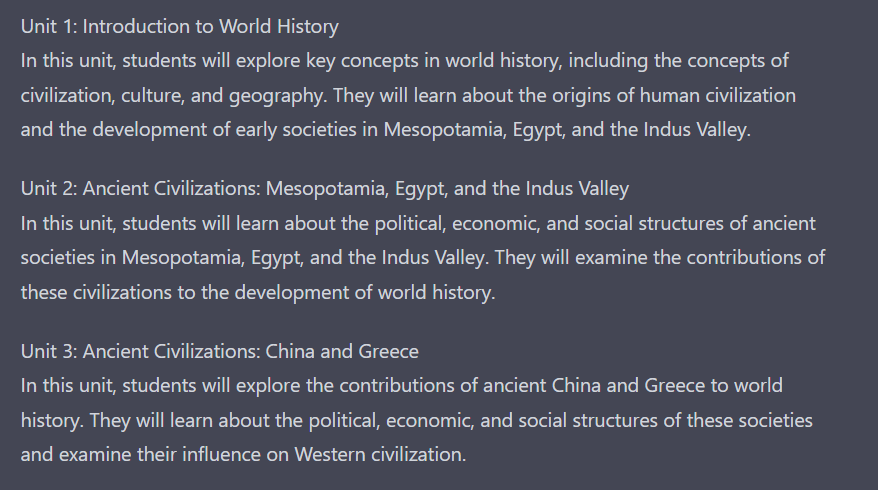
Honestly, this stuff is great. This is a lot more framework and would be the kind of outline a teacher might expect to be given by a school. However, there is one huge issue.
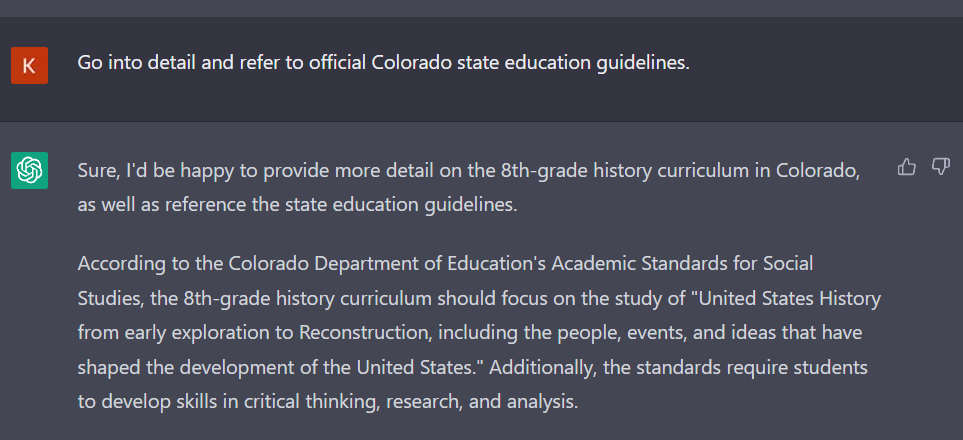
This curriculum doesn’t actually adhere to the state-defined purpose of the course. While the outline provided is a solid curriculum, it’s not up to the guidelines for the state. This is a major issue for a teacher as following it would fail to prepare students for the end-of-year tests.
So, with that in mind, I asked ChatGPT to re-evaluate its parameters.
“Create a one-year curriculum for 8th-graders focused built around "United States History from early exploration to Reconstruction, including the people, events, and ideas that have shaped the development of the United States."
OK, now we’re getting somewhere. This is a really good outline that is broken down by month and goes into detail about each unit and what students will learn.
The big takeaway here is that ChatGPT can absolutely create a curriculum to specific standards, but, at least for now, you need to be very specific about what you want.
Lesson Planning
OK, we’ve got a curriculum. What’s next? Lessons of course. If a curriculum is a roadmap, your lesson plans are turn-by-turn directions and a clear lesson plan will save you major headaches during actual class time.
Working from this curriculum, I asked ChatGPT to create a lesson plan for the first lesson.
“Create a lesson plan for unit 1, class 1”
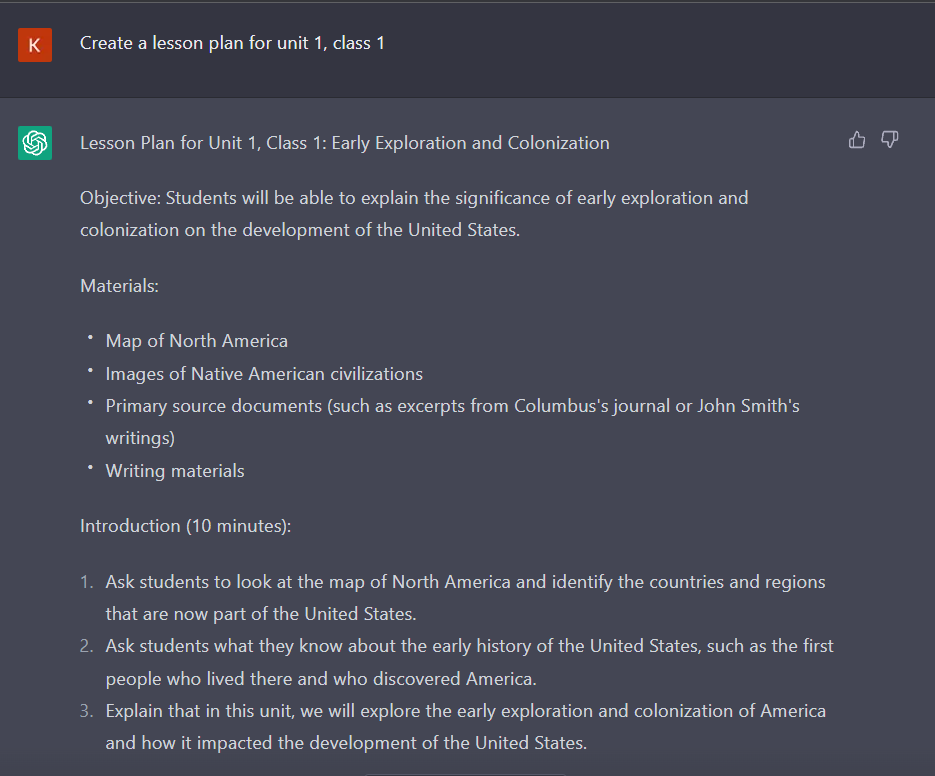
Once again, we’re halfway there after just a single prompt. It’s a full one-hour lesson plan broken down into segments that are each further explained. For an experienced teacher, this is enough to work with.
But newer teachers might find this just as frustrating as no instruction at all. Having a lesson plan and putting together actual activities are two very different things. Looks like ChatGPT can help with that, too. I asked for a list of activities to do in class.
“What kinds of in-class activities would be engaging and appropriate for this class?”
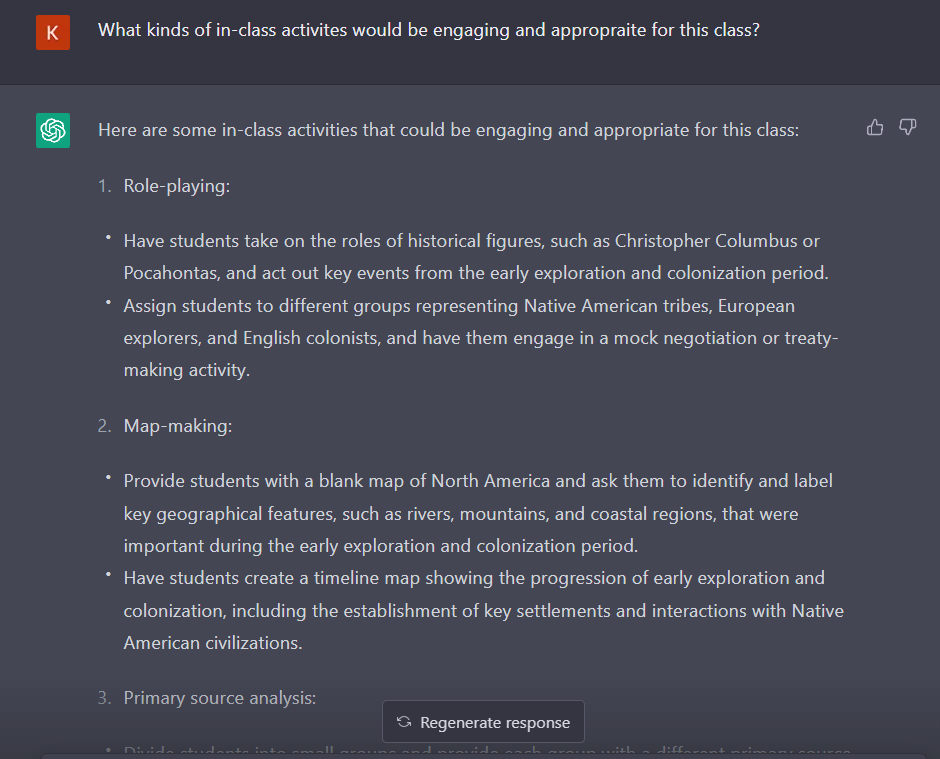
None of these are groundbreaking and some of the suggestions might be a bit outdated (thanks to old training data, but that’s another issue entirely), but it’s more than enough to actually build a class around.
Of course, knowing where to find further information on a subject is always a plus.
“What outside references would be appropriate for this class?”
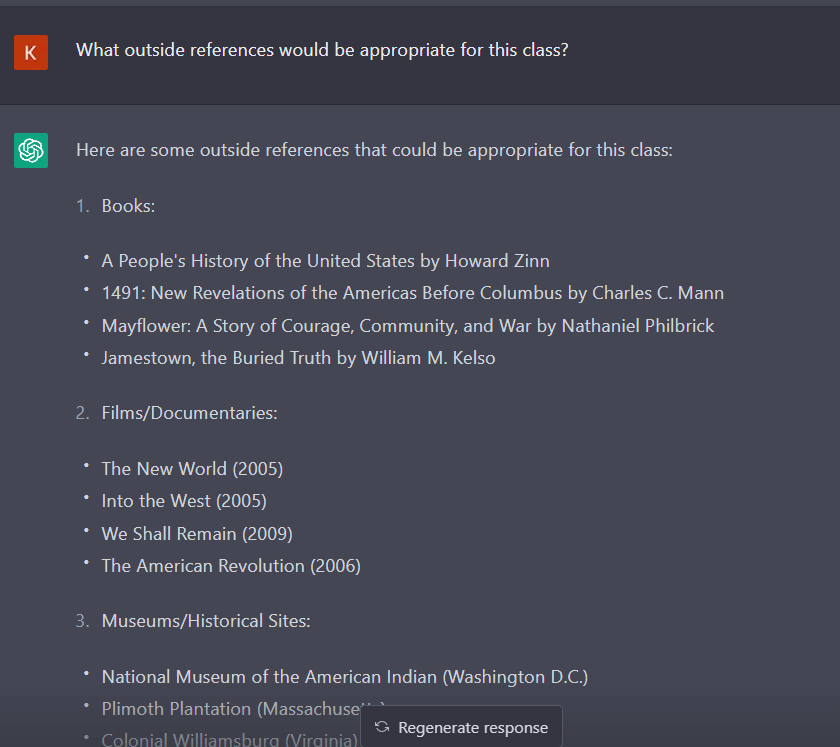
Grading Essays
Time spent outside of class isn’t all preparing for classes. One of the most time-consuming and tedious tasks that teachers have to deal with is grading. This is especially true if what’s being graded is essays. There’s only so fast that a person can read and evaluate text.
Thankfully, ChaptGPT can do that task infinitely faster than any human. To see just how well AI could evaluate homework, I fed it an essay written by an 8th-grader on Romeo & Juliet. Specifically, I asked the AI to
“Evaluate and grade this essay from the standpoint of an 8th-grade English teacher.”

The chatbot was quick to lower my expectations.

Fair enough, it doesn’t have its own preferences but what about the actual evaluation? Well, overall, ChatGPT evaluated the essay as very good giving it a B+/A- and stating that the essay ”effectively highlights the importance of love, hate, and fate in the play.
I’ve got say, though, that this is incredibly generous. This essay reads like it was regurgitated straight from Wikipedia by someone who has no understanding of the text at all. So, you know, a standard 8th-grader.
However, as a former English teacher, this essay is worth little more than a C-. The essay is clear and concise, but it lacks anything close to a personal interpretation.
Drafting Emails
Dealing with parents is one of the worst parts of any teacher’s job. Every parent wants what's best for their child and—some—can take out their frustrations on the teacher. Responding to angry emails from parents complaining that their child isn’t getting all As is an exercise in patience and is absolutely a contributor to teacher burnout. Using CHatGPT can help alleviate some of that pressure.
I put it in a pretty mundane email from a parent asking about her daughter’s performance and asked ChatGPT to respond.
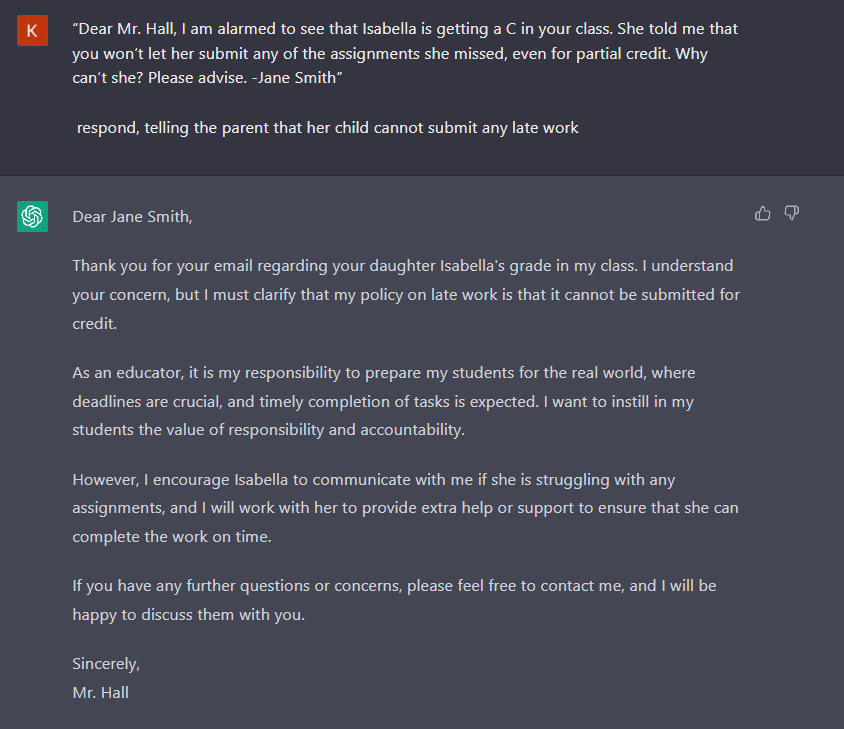
This is fine. It’s direct and professional if a little pointed. It certainly doesn’t match the tone I would want to take. I asked ChatGPT to “make it a bit softer”.
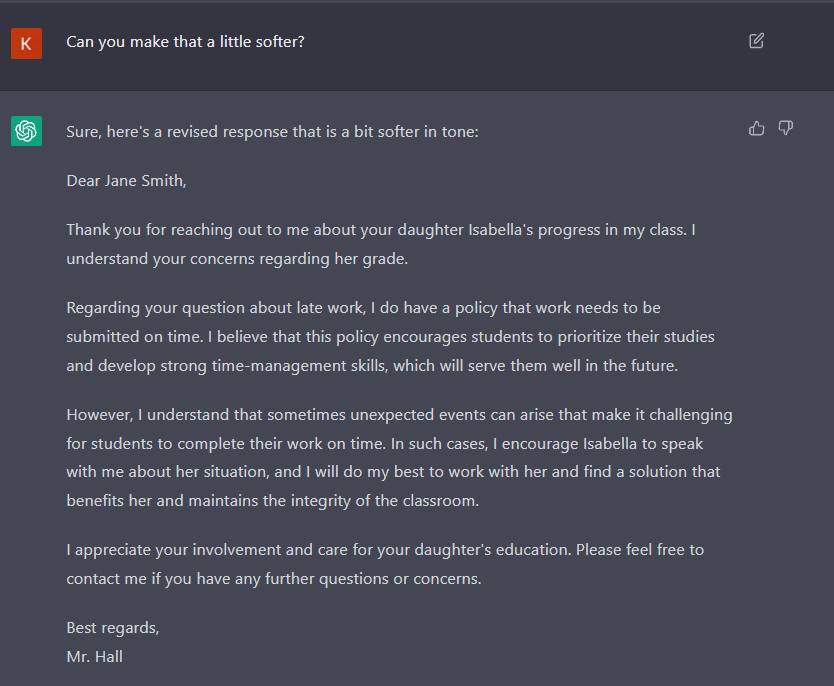
OK, that’s good. I could send that to a parent and not worry about it making them any angrier.
What Should Teachers Beware Of?
AI is far from perfect. The biggest issue is letting it become a crutch and losing the ability to think and plan on your feet. This is likely a small issue as most teachers are more than skilled enough at this as it is, but it’s a real risk.
Any talk of AI in the classroom has to mention the elephant in the room; will students use this to cheat? Yes. Of course they will. But that doesn’t mean that it will work. As it stands, AI is simply not at the level of producing truly natural human language. As I discussed above with regard to email, the tone is clean and professional but it lacks any real soul. Though I feel that this won’t stay true much longer.
Oh, and that Romeo & Juliet essay from earlier? That was written by an AI. It seems that ChatGPT grades itself much higher than humans do, so if you’re using it for evaluating essays, really take its recommendations with a grain of salt.
And none of this even begins to touch on the risks of bias in the training data provided to AI.
Why Should Teachers Use AI?
At the end of the day, teachers and administrators should be embracing AI as a major time-saving investment. There’s no doubt that Ai can assist teachers both in and out of the classroom as a powerful tool.
Any teacher will tell you that burnout from the job is very real. Much of this comes from the outside work that goes into teaching. Being in the classroom is why we do it and the paperwork is just a price that we pay. Anything that minimizes the time I spend getting ready to teach helps me to do my best in the classroom.
Further Reading on using artificial intelligence to aid teachers
AI in the Classroom: Ways Teachers Use AI tools today
Benefits of AI in Education: Integrating AI into Teaching and Learning